#circa 1904
Text

Die Zwei Brüder / The Two Brothers
1902/04
Artist : Otto Ubbelohde
#brüder grimm#the brothers grimm#brothers grimm#frères grimm#die zwei brüder#the two brothers#Les deux frères#children's literature#children's illustration#fairy tale#children's books#fairy story#vintage illustration#children's book#fairy tales#old illustration#early 20th century#circa 1904#1904s#otto ubbelohde
989 notes
·
View notes
Text

ART NOUVEAU - Gold and enamel brooch by Gaston Lafitte - c 1904
#art nouveau#art nouveau jewelry#plique a jour#butterfly#diamond#gold#enamel#enamelled gold#brooch#gaston lefitte#circa 1904
353 notes
·
View notes
Text

#historical fashion polls#fashion plate#fashion poll#historical dress#historical fashion#dress history#fashion history#20th century fashion#early 20th century#20th century#1900s style#1900s dress#1900s fashion#circa 1900#early 1900s#1900s#circa 1904
31 notes
·
View notes
Text
Y’all I just found out about the 1904 Olympics marathon and I am losing my mind over how batshit insane it was. Buckle up y’all because this is one hell of a story
For some historical context, the 1904 Olympics were held in St. Louis and it was the first Olympics hosted in the U.S. It was paired up with the 1904 World’s Fair, so there was a hell of a lot going on in the city at the time
First, let’s meet some of our contestants:
American Thomas Hicks and four other Americans were all experienced marathoners
American Fred Lorz, who was able to compete after placing in a “special five mile race” sponsored by the Amateur Athletic Association. He did all his training at night
Ten Greeks who had never run a marathon before
Two South African men from the Tsuana tribe who were in St. Louis as part of the World’s Fair. They were apparently the first black Africans to compete in the Olympics, which is super cool. Less cool was the fact that they weren’t wearing any shoes
Cuban Félix Carbajal, a 5ft (1.5m) tall man who had fundraised his journey to the Olympics. This man got to New Orleans, lost all his money on a dice game, then had to walk and hitchhike his way to St. Louis. Mind you, that is almost 700 miles. He shows up to the race, having not eaten in 40 hours, dressed like THIS:
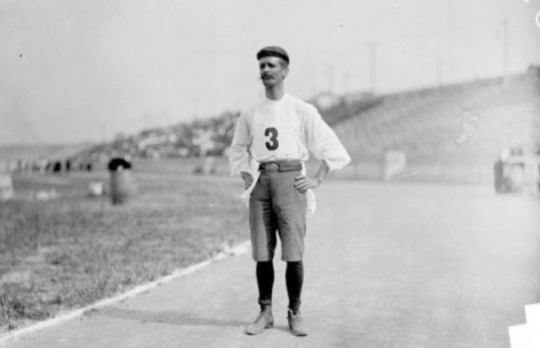
This man gets another bullet point because apparently his trousers were all the way down to his boots when he got there. Another Olympian took pity on him and cut them with scissors
Now for the race itself. It is in the 90s (32 degrees Celsius) and humid. For some god awful reason, they decided to start the race at 3pm, so it’s the hottest part of the day. The course is only 24.85 miles (40km) long instead of a standard 26.2, but that doesn’t mean this was an easier race. On the fucking contrary, it was hellish. I’ll let the Smithsonian article about this explain it because they do it much better than I ever could:
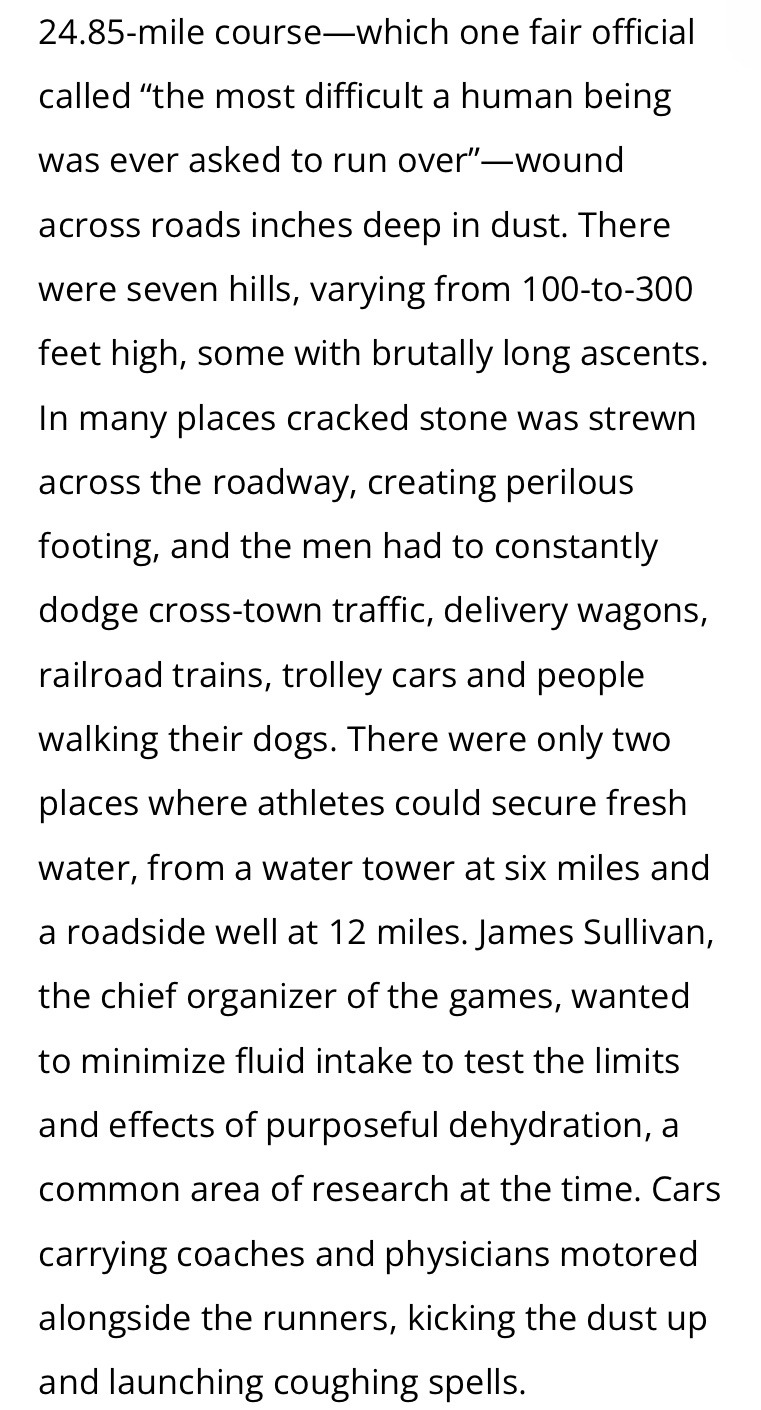
Now, I’ve never ran a marathon before, but I looked it up and the current recommendation is that water stations are placed every two miles.
The race is a go and things are off to a nasty start. American William Garcia almost becomes the first fatality of an Olympic event because he inhaled so much dust that his stomach was hemorrhaging. He was found unconscious by the side of the road by a local couple and had to be hospitalized. Apparently he would have bled to death if he’d been left for an hour longer.
But the dust isn’t the only issue. Apparently, Len Taunyane, one of our South African participants, gets chased a mile off course by wild dogs. He still placed 9th.
Probably my favorite participant is our boy Félix. Félix was stopping to chat with spectators in the middle of an Olympic race. At one point he stopped a car because he saw that the riders were eating peaches and asked if he could have some. They refused, but he snatched two anyway and ate them while he ran. He later came across an orchard and stopped to eat some apples, but apparently the apples were rotten, so he got stomach cramps and took a nap. HE STILL GOT FOURTH PLACE. That’s how much of a shitshow this race was, and we’re not even done.
Fred Lorz starts getting cramps around the 9-mile mark and decides to hitch a ride with one of the cars that is guiding them. He’d been leading the charge for a while and was a crowd favorite to win.
The other leader of the pack and favorite to win, Thomas Hicks, started having to use a support crew at the 10-mile mark. He was begging them for water, but they refused. He somehow managed to keep trucking along, though.
Seven miles from the finish line, Hicks’ handlers started feeding him egg whites mixed with strychnine, which is literally rat poison. There were literally no rules against performance-enhancing drugs yet, so this was apparently above-board.
Lorz gets out of the car he was riding in after 11 miles and just,,,, kept running????? He finished the race and was declared the winner. He was about to be given a gold medal when “someone called an indignant halt to the proceedings with the charge that Lorz was an imposter.” Lorz claimed it was all a joke and that he wouldn’t have actually accepted the award, but was still banned from competing in future marathons. That is, of course, until this decision was overturned in time for him to run in and win the Boston Marathon the next year.
Now Hicks had seen Lorz pass by. He was not doing too hot at all, but finding out that Lorz had been disqualified and he was still in the lead helped his motivation. He was given another dose of egg whites and strychnine with some brandy to wash it down, which, sure. Why the fuck not at this point?
At this point, he began to hallucinate. He started to believe that he had 20 more miles left to go instead of just two. He kept begging for food and rest, but his handlers just gave him more brandy and two more egg whites because of course he was. By the time he made it to the finish line, he was literally being carried by his handlers while his feet shuffled, but that was apparently good enough and he was declared the winner.

It took four doctors and a full hour for Hicks to recover enough to even leave the area after the race. He apparently lost eight fucking pounds during the course of the race. Hicks pretty much retired from racing after that (I wonder why) and became a professional clown, which really is just the cherry on top
Of the 32 people who competed in the race, only 14 finished. After everything, they literally almost removed the marathon as an Olympic event because it was deemed “indefensible on any ground but historic,” and honestly? After reading all that fuckery, I can’t even blame them.
Another note about Félix, because this man baffles me: apparently he was sponsored by the Greek government to compete in a 1906 marathon in Athens, but he never turned up. Newspapers in Cuba claimed he died, but he just??? Showed up a year later in Havana perfectly fine. Turns out he managed to get the date of the marathon wrong.
Sources:
#m rambles#long post#history#Olympics#st. louis#circa 1904#the more you know#I just needed to share this with you all#I almost just linked the articles I read but I felt impassioned to type everything out#what a wild ride
16 notes
·
View notes
Text

Procissão de Encontro (Nossa Senhora das Dores e o Senhor Bom Jesus dos Passos) no Pátio da Santa Cruz no Bairro da Boa Vista - Centro do Recife Em 1904.
#Semana Santa#Páscoa#Procissão dos Passos#Senhor Bom Jesus dos Passos#Nossa Senhora das Dores#Recife#Recife City#Recife Pernambuco#Antigamente#efemerides#pernambuco#nordeste#photography#photo#old photography#old photo#vintage#vintage photography#Fotografia#Fotografia Antiga#Circa 1904#1900s#Foto Antiga
8 notes
·
View notes
Text


Some Edwardian Molly for the soul
#hetalia#historical hetalia#my art#hws ireland#nyo!ireland#you can tell which side is my non-dominant side to draw on lol#i wanted to try drawing period clothing from a reference#the clothing i referenced was circa 1904-1905 i believe#anyway maybe this will get me into the ask blog spirit 😭
30 notes
·
View notes
Text
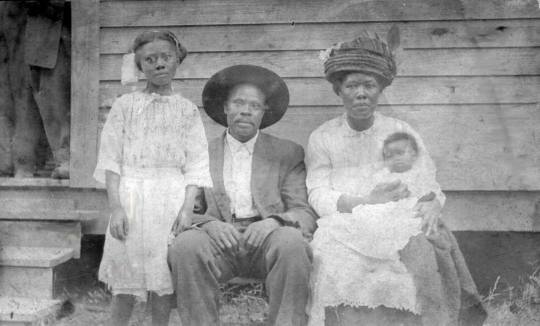
26 notes
·
View notes
Text

Burial monument in bronze. Staglieno Cemetery, Genoa, Italy circa 1904
1K notes
·
View notes
Text

Lion in the Desert (circa 1885) | Jean-Léon Gérôme (1824-1904)
1K notes
·
View notes
Text


Large and heavy, ultra-complicated gold double-dialled perpetual calendar keyless lever minute repeating grande and petite sonnette clock watch with equation of time, signs of the zodiac, times of sunrise and sunset, moonrise and moonset, moon phases with apparition of the Big Dipper/Plough at alternate black moons, circa 1904, Unknown craftsman.
898 notes
·
View notes
Text

Always There, Women in Motorsport: The fast women of la belle époque
Women's history in motorsport is rich, and that has always been the case. Most of these stories however aren’t well known and aren’t spoken about enough. Women have always been in motorsport and always will be.
Three French women, Hélène van Zuylen, Camille du Gast, and Anne de Rochechouart de Mortemart are some of the fastest women from France’s La Belle Epoque (circa 1880-1914).
In 1898 Anne de Rochechouart de Mortemart (1847-1933) (also known as the Duchess of Uzes) became the first woman in France to obtain her driver’s license. While getting out of the car she announced with delight that woman had just overcome a new barrier. Not long after she also became the first to be caught speeding for which she had to pay a five franc fine.
in 1926 she founded the first female Automobile Club, L'Automobile Club féminin de France (ACFF)

The Duchess of Uzes in 1927
Hélène van Zuylen (pictured on the cover image) was a French author but also the first woman to compete in an international auto race. Baron Etienne van Zuylen, her husband, was the President of the Automobile Club de France
She entered the 1898 Paris–Amsterdam–Paris using the nickname Snail, while her husband used the nickname Escargot. She successfully competed the trail and entered the Paris-Berlin race in 1901 but was stopped by technical failure.
That year Hélène, a lesbian, would meet Renée Vivien with whom she would have an affair. Vivien's letters to a confidant revealed that she considered herself married to Hélène. Most of Vivien's work is dedicated to "H.L.C.B.," the initials of Zuylen's first names.
Just over a decade before she died, Hélène van Zuylen created the Renée Vivien Prize, Honoring the woman she loved and intending to give encouragement to female writers.
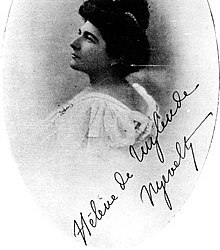
Hélène van Zuylen - Nouvelle Revue internationale illustrée, December 1908
Camille du Gast (1868-1942) finished 33rd (19th in class) out of 122 participants in the 1901 Paris-Berlin race. Du Gast, achieved the results despite driving her husband's 20CV Panhard-Levassor which was not designed for racing. She had to start the race in last because she was a woman. The race did mark 2 female competitors with du Gast and van Zuylen. She loved several extreme sports such as mountaineering, parachuting and frencing.
In 1902 she competed in the Paris-Vienna race and also wanted to compete in the New York-San Francisco but was refused entry because she was a woman.
In 1903 she would start the Paris-Madrid race. Which she would enter with a proper racing car, a works 5.7-litre de Dietrich car. It was a chaotic race with 207 competitors which unfortunately saw several deaths. Camille started in 29th and gained 9 positions in the first 120 km. She had climbed up to P8 before stopping to give medical aid to a fellow driver, Phil Stead (also driving a de Dietrich) involved in a near-fatal crash.
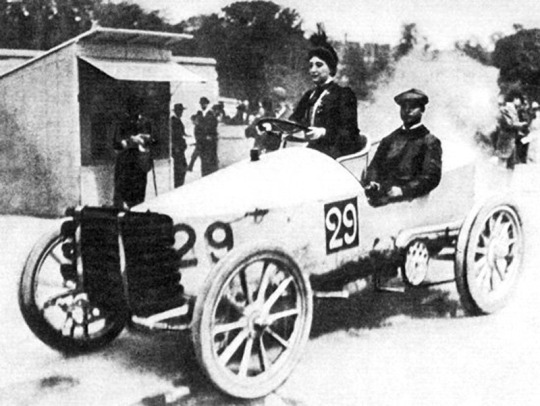
Camille du Gast in her 30 hp De Dietrich with starting number 29 during the 1903 Paris-Madrid Race
Later one of the leading drivers at that time, Charles Jarrot said that if Camille had not stopped Stead likely would have died. After an ambulance arrived she continued the race eventually finishing 44th or 45th in the shortened race.
The French government would stop the race at Bordeaux, as over half of the field (275 cars) had either crashed or retired and several drivers and spectators had died.
Open road racing was banned, so in 1904 Camille wanted to participate in the French elimination trial for the Gordon Bennett races, as the Benz factory team offered du Gast a race seat. But the Autosport Club France (ACF) banned women from racing. Du Gast published a letter in protest but the ban was defended as the ACF could not risk a woman getting injured or killed in a racing event.
Because of this she ventured to boat racing. One of those races was caught by a big storm which saw most competitors either abandon their ship or they sank. She was rescued and later declared the winner of that race.
Eventually she had to put a halt to her adventurous life when she survived an assassination attempt by her daughter. Nothing was ever the same for her after that. From that point she devoted herself to animals. She would serve as president of the 'French Society for the Prevention of Cruelty to Animals'
NEXT UP > More female racing drivers from the early 1900s
#Hélène van Zuylen#Camille du Gast#Anne de Rochechouart de Mortemart#Women's Motorsport History#*History Series#*History Series: Always There Women in Motorsport#Women in Motorsport#Also a little bit of queer motorsport history !#international women's day
145 notes
·
View notes
Photo
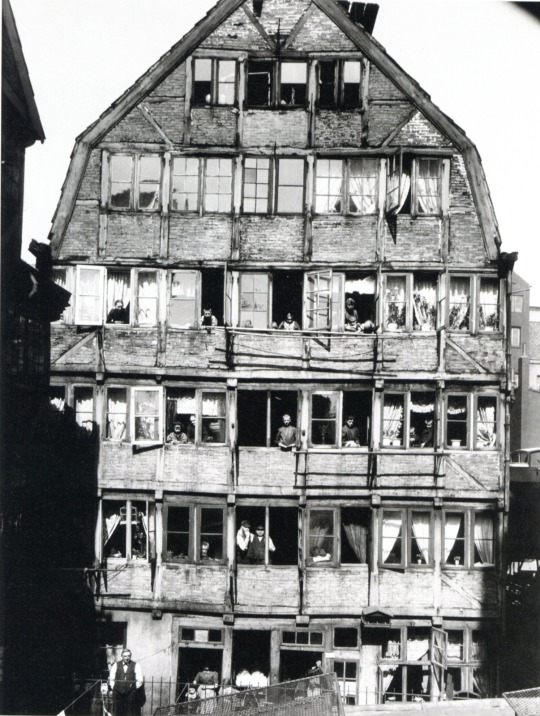
House and people living in it in Hamburg, Germany. Circa 1904.
1K notes
·
View notes
Text

Daum
“Vignes et escargots” lamp
in multi-layered glass and vitrified coloured powders, with acid-etched decoration of vine shoots, punctuated by applied snails.
Signed.
Circa 1904
Tajan
108 notes
·
View notes
Text

'Autumn' (circa 1898) by Bessie Macnicol (Scotland, 1869-1904)
Oil on canvas.
Aberdeen City Council (Archives, Gallery and Museums Collection)
Wikimedia.
157 notes
·
View notes
Text








e.e. cummings, from “Ballade” (in Uncollected Poems), Complete Poems: 1904-1962 // From Supermoon 2016, one of 21 photos. Crowds look on as the supermoon rises behind the Fremantle War Memorial at Monument Hill on November 14, 2016, in Fremantle, Australia. (Paul Kane) // Mizuta Masahide, 17th Century Japanese Poet & Samurai // moonchild by rm (translation credits by doolset lyrics) // picture by my dear @taeoreomcflurry // Alexander Calder, Moon and Sun, on a blue background, circa 1970 // Clarice Lispector, from "Água Viva" (tr. by Stefan Tobler) // Mahmoud Darwish.
118 notes
·
View notes
